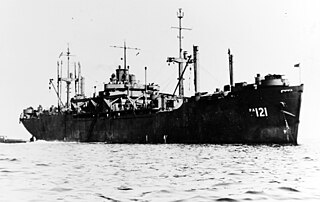
USS Anzio (ACV/CVE/CVHE-57), was a Casablanca-class escort carrier of the United States Navy that saw service during World War II in the Pacific War. Originally classified as an auxiliary aircraft carrier ACV-57, the vessel was laid down in 1942, in Vancouver, Washington, by the Kaiser Shipbuilding Company and initially named Alikula Bay, then renamed Coral Sea and redesignated CVE-57 in 1943. Coral Sea took part in naval operations supporting attacks on the Gilbert and Marshall Islands, New Guinea and the Marianas Islands. In September 1944, she was renamed Anzio. As Anzio, the escort carrier took part in assaults on the Bonin Islands and Okinawa. Following the cessation of hostilities in 1945, Anzio was among the escort carriers used in Operation Magic Carpet, returning US soldiers to the United States. Following this service, she was laid up in reserve at Norfolk, Virginia, in 1946. The escort carrier was redesignated CVHE-57 on 15 June 1955, before being sold for scrap in 1959.

USS O'Flaherty (DE-340) was a John C. Butler-class destroyer escort built for the United States Navy during World War II. She was named for Ensign Frank Woodrow O'Flaherty, a pilot who posthumously received the Navy Cross for his actions at the Battle of Midway.

USS Pakana (AT–108) was an Abnaki-class fleet ocean tug. It was named after the Pakana, a Native American tribe of Texas. This ship saw service in the Pacific theater of World War II, and was later transferred to the United States Bureau of Mines for use in Alaska before being deliberately sunk in 1975.

USS Zebra (AKN-5) was an Indus-class net cargo ship in the service of the United States Navy in World War II. The ship was originally the Matthew Lyon, an EC2-S-C1 Liberty ship, operated for the War Shipping Administration (WSA) as a cargo vessel by an agent until severely damaged by torpedo in August 1943. While at Espiritu Santo in the New Hebrides awaiting likely scrapping the Navy acquired the vessel under bareboat charter to be used as a net cargo ship transporting reclaimed anti-submarine netting.

USS Lanier (APA-125) was a Haskell-class attack transport in service with the United States Navy from 1944 to 1946. She was scrapped in 1973.

USS Highlands (APA-119) was a Haskell-class attack transport built and used by the US Navy in World War II. She was a Victory ship design, VC2-S-AP5. She was named after Highlands County, Florida, United States.

USS Hendry (APA-118) was a Haskell-class attack transport of the US Navy that was built and served in World War II. She was of the VC2-S-AP5 Victory ship design type. She was named after Hendry County, Florida.

USS Hocking (APA-121) was a Haskell-class attack transport in service with the United States Navy. from 1944 to 1946. She was scrapped in 1974.

The second USS Ardent (AM-340) was a Auk-class minesweeper in the United States Navy.

USS Halloran (DE-305) was a Evarts-class destroyer escort of the United States Navy.
USS Annoy (AM-84) was an Adroit-class minesweeper of the United States Navy. She was laid down on 3 December 1941 at Portland, Oregon, by the Commercial Iron Works; launched on 6 April 1942; and commissioned on 2 September 1942. In 1944 she was reclassified as a patrol craft and renamed PC-1588.
USS Spectacle (AM-305) was a steel-hulled Admirable class minesweeper built for the U.S. Navy during World War II. A trained crew boarded the new vessel, practiced with her minesweeping gear, and then proceeded to the Pacific Ocean to clear mines from Japanese beaches so that Allied forces could invade. While performing this dangerous task of mine clearance, a Japanese plane strafed her, and another deliberately crashed into her. When she returned to the United States, her battle damage was so severe that the U.S. Navy decided to scrap, rather than to repair, her. She was awarded two battle stars.
USS Tekesta (AT-93) was Navajo-class fleet tug built during World War II for the United States Navy. Shortly after being built, it was crewed by trained Navy personnel and sent into the Pacific Ocean to provide tug service to damaged ships in battle areas. For successfully performing this dangerous work, she was awarded four battle stars by the war's end.

USS Hamlin (AV-15) was a Kenneth Whiting-class seaplane tender in the United States Navy.
USS LST-888 was an LST-542-class tank landing ship built for the United States Navy during World War II. Late in her career she was renamed Lee County (LST-888) – after counties in twelve Southern and Midwestern states, the only U.S. Naval vessel to bear that name – but saw no active service under that name.

USS Preserver (ARS-8) was a Diver-class rescue and salvage ship commissioned by the U.S. Navy for service in World War II. She was responsible for coming to the aid of stricken vessels.

USS Shackle (ARS-9) was a Diver-class rescue and salvage ship commissioned by the U.S. Navy for service in World War II. She was responsible for coming to the aid of stricken vessels.
USS Valve (ARS-28) was a Diver-class rescue and salvage ship commissioned by the U.S. Navy during World War II. Her task was to come to the aid of stricken vessels.
USS Clamp (ARS-33) was an Diver-class rescue and salvage ship acquired by the U.S. Navy during World War II. Her task was to come to the aid of stricken vessels.
USS Winterberry (AN-56/YN-75) was an Ailanthus-class net laying ship which served with the United States Navy in the Pacific Ocean theatre of operations during World War II. Despite being attacked near Okinawa by enemy suicide planes, she managed to return safely home after the war with the ship bearing one battle star.












